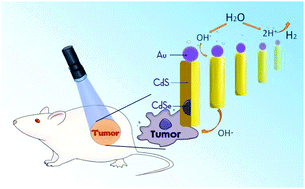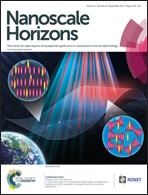A metal–semiconductor nanocomposite as an efficient oxygen-independent photosensitizer for photodynamic tumor therapy†
Abstract
Photodynamic therapy (PDT) is regarded as one of the most promising cancer treatments, and oxygen-independent photosensitizers have been intensively explored for advancing the development of PDT. Here, we reported on a superior hybrid nanocomposite (HNC) consisting of a metal (Au deposition) and a semiconductor (CdSe-seeded/CdS nanorods) as a photosensitizer. Under visible light, the photogenerated holes were three-dimensionally confined to the CdSe quantum dots and the delocalized electrons were transferred to the Au tips, which provided hydrogen and oxygen evolution sites for water splitting to generate reactive oxygen species (ROS) with no need for oxygen participation. Compared with semiconductors without deposited metal (i.e. raw CdSe-seeded/CdS nanorods (NRs)) under a normoxic or hypoxic environment, the HNCs exhibited substantially enhanced light-triggered ROS generation in vitro. After being modified with an Arg-Gly-Asp (RGD) peptide sequence, the nanocomposite was deemed as a tumor-targeting, long-lived and oxygen-independent photosensitizer with promoted PDT efficiency for in vivo anti-tumor therapy. This oxygen-independent nanocomposite successfully overcame the hypoxia-related PDT resistance by water splitting, which opened a window to develop conventional semiconductors as photosensitizers for effective PDT.



 Please wait while we load your content...
Please wait while we load your content...